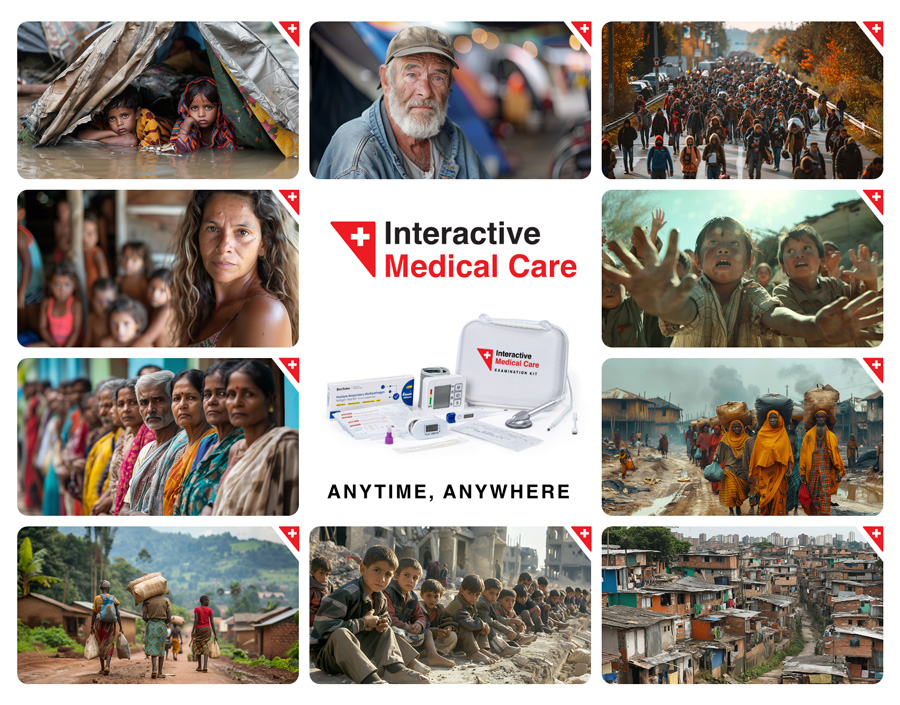
Medically Efficient Online Diagnosis
Interactive Medical Care is revolutionizing access to healthcare by providing global real-time diagnostic capabilities for patients through healthcare professionals. Our mission is to provide the most direct, reliable and efficient solution for healthcare consultations where it needed the most. We want to ensure that quality healthcare is accessible to everyone, regardless of their location or circumstances.


We have developed a state-of-the-art remote medical diagnostic set combined with a robust software platform that enables real-time consultations between patients and medical professionals. This advanced system enables doctors and specialists to perform comprehensive medical examinations online with their patients anywhere in the world, using common integrated medical tools, including:
- Stethoscope: For listening to heart, lung and other body sounds.
- Otoscope: For examining the ears.
- Thermometer: For measuring body temperature.
- Blood pressure monitor: For assessing cardiovascular function.
- Urinalysis test strips: For the detection of inflammation in the urinary tract.
- Pulse oximeter: For measuring the oxygen content in the blood.
- Multipathogen antigen test kit: For testing respiratory pathogens, including influenza A and B, RSV and SARS-CoV-2.
These medical instruments, which have been used in face-to-face diagnosis for decades, are connected online to our proprietary software. Medical professionals can diagnose patients with the same precision as in face-to-face consultations in doctors’ offices and during home visits. Even in the most remote or medically underserved areas, patients can receive high-quality healthcare without the need for mobility or local infrastructure. This saves costs and time while providing basic medical care for accurate diagnoses.

Benefits for Global Healthcare

The benefits of our technology are far-reaching. Our remote diagnostics set addresses several critical challenges in global healthcare:
- Access to medical care in remote and underserved areas: Many areas around the world have little or no access to basic medical care due to geographical isolation. Our solution allows the doctors to provide a physical examination remotely and in real-time directly to the patient and provides reliable medical services in regions where medical facilities are scarce or non-exist. This applies to underserved areas in both industrial-ized and developing countries.
- Cost relief for overburdened healthcare systems: In densely populated urban areas, healthcare systems are often overwhelmed by high demand. Doctors have to diagnose and treat many patients both in doctors’ surgeries and before home visits. This takes a lot of time with ever-increasing costs for travel, infrastructure and staff. Our technology offers a scalable solution to reduce the burden on healthcare providers by enabling re-mote consultations and thus reducing the patient load in doctors’ surgeries, in hospi-tals and during home visits.
- Rapid assistance in crisis and emergency situations: In disaster areas or during health crises, existing healthcare services may fail. Our remote medical diagnostic kit is designed to be portable and easy to use. This makes it a valuable solution for emergen-cy medical teams and humanitarian organizations.
- Cost-effective healthcare for NGOs: By minimizing the need for physical infrastructure and travel, our remote medical diagnostic kit significantly lowers the cost of healthcare for patients, making it an attractive option for non-profits and organizations operating under strict budget constraints.
Why enter into a partnership with us?
We believe that partnership is key to the efficient realization of our technology. By working with us, we can jointly extend the reach of your healthcare initiatives and provide real-time, high-quality consultations for all relevant stakeholders. Our solution goes beyond technology. We enable accurate and cost-effective diagnoses and ensure humane primary healthcare. In doing so, we save lives and improve health outcomes worldwide.

Our commitment
At Interactive Medical Care, we are committed to the continuous pursuit of excellence for doctors and patients and technological innovation. We aim to provide solutions that are not only effective, but also fit the diverse needs of all stakeholders. Our team of experts will work closely with each prospect to customize our technology and ensure seamless integra-tion with existing programs and initiatives.

efficient healthcare for all
In a world where access to healthcare is still a significant barrier for millions of people, we offer a smart solution that makes a real difference. By partnering with us, together we can empower healthcare professionals to deliver timely and effective care to all those who need it most, wherever they are. We look forward to the opportunity to present our solution, collaborate with you and realize our mission. We want to provide access to dignified, accurate and efficient healthcare for all people worldwide.

Remote medical consultation with the proper medical tools offers significant advantages over standard telemedicine, mainly because it enhances the quality and accuracy of the diagnosis and treatment:
- Enhanced Diagnostic Accuracy
- Real-Time Data Collection: With remote medical tools like digital stethoscopes, otoscopes, or portable ultrasound devices, healthcare providers can gather real-time, objective data. This allows them to make more accurate diagnoses compared to relying solely on a patient’s verbal description of symptoms.
- Better Monitoring: Continuous monitoring tools (e.g., wearables measuring heart rate, oxygen levels, or blood pressure) enable physicians to track health metrics over time, catching issues that might not be apparent in a single telemedicine session.
- Comprehensive Physical Examination
- Physical Examinations: Remote consultation with medical tools can replicate parts of an in-person physical exam. For instance, a doctor can listen to a patient’s heart or lungs using a digital stethoscope connected via the internet, providing insights that wouldn’t be possible in a regular video call.
- Imaging Capabilities: Some remote tools allow for basic imaging (like portable ultrasound devices), providing critical visual information that enhances diagnostic capabilities far beyond what a verbal consultation can offer.
- Improved Patient Safety
- Immediate Action: If remote tools detect a serious issue, healthcare providers can intervene more quickly, potentially preventing complications. For example, detecting an irregular heartbeat through a remote ECG could prompt an immediate in-person visit or even emergency care.
- Reduced Misdiagnosis: The added data from these tools reduces the risk of misdiagnosis, which is higher when relying solely on patient-reported symptoms.
- Patient Empowerment and Engagement
- Better Understanding: Patients can use tools at home, often leading to a better understanding of their own health. This active involvement can lead to improved compliance with treatment plans.
- Immediate Feedback: Patients can receive immediate feedback on their condition or how well a treatment is working, leading to better outcomes and adjustments to care when needed.
- Increased Access to Specialist Care
- Remote Specialist Access: Some patients may need consultations with specialists who are not locally available. With the proper tools, specialists can remotely assess patients with almost the same accuracy as if the patient were in their office, expanding access to high-quality care.
- Cost-Effectiveness
- Fewer In-Person Visits: Enhanced diagnostic tools reduce the need for follow-up visits or hospital trips, cutting costs for patients and healthcare systems.
- Resource Efficiency: These tools make it possible to manage chronic conditions more effectively at home, reducing the strain on healthcare facilities and resources.
- Convenience and Comfort
- At-Home Care: Patients don’t need to leave their homes, which is particularly beneficial for those with mobility issues or those living in remote areas. This convenience doesn’t compromise the quality of care when proper tools are used.
- Reduced Anxiety: Many patients feel more comfortable in their own homes, which can lead to better communication with healthcare providers and a clearer picture of the patient’s typical health state.
In summary, remote medical consultation equipped with the right medical tools bridges the gap between telemedicine and in-person visits, providing a more comprehensive, accurate, and effective approach to patient care.

Real-time consultation offers several medical and safety benefits over simply sending data over the network for later analysis:
- Immediate Clinical Decision-Making
- Rapid Response to Emergencies: In real-time consultations, healthcare providers can immediately interpret data and assess the patient’s condition. If an emergency is detected, they can provide immediate instructions or interventions, which can be critical for conditions like heart attacks, strokes, or severe infections.
- Dynamic Adjustment of Care: Providers can adjust treatment plans or medications on the spot based on real-time data, improving outcomes and reducing the risk of complications.
- Interactive Patient Assessment
- Two-Way Communication: During real-time consultations, patients can describe symptoms as they occur, ask questions, and clarify concerns immediately. This interactive element helps the provider get a more complete picture of the patient’s condition and can lead to a more accurate diagnosis.
- Live Feedback on Procedures: If a procedure or test is being conducted remotely, the healthcare provider can guide the patient or technician in real-time, ensuring that the procedure is done correctly and safely.
- Improved Diagnostic Accuracy
- Contextual Understanding: Real-time interaction allows the provider to observe the patient’s behavior, physical appearance, and responses during the consultation. This context can be crucial for diagnosing conditions that may not be apparent from data alone, such as anxiety, pain levels, or subtle neurological signs.
- Immediate Data Correlation: Providers can correlate data with the patient’s real-time symptoms, which is often more accurate than interpreting isolated data points sent later.
- Safety in Interpretation and Action
- Reduced Misinterpretation Risk: Real-time consultations reduce the risk of data being misinterpreted due to lack of context or errors in data transmission. Providers can verify readings or ask follow-up questions immediately, leading to safer care.
- Immediate Clarification: If there’s any doubt or confusion about the data or its implications, the provider can seek immediate clarification from the patient, reducing the chance of errors in diagnosis or treatment.
- Enhanced Patient Compliance and Engagement
- Real-Time Guidance: Providers can offer immediate guidance on how to use medical devices or follow treatment plans, which improves patient compliance and safety. For example, if a patient is using an inhaler incorrectly during the consultation, the provider can correct their technique in real time.
- Empathy and Reassurance: Real-time interactions allow for emotional support and reassurance, which can be crucial for patients dealing with anxiety, chronic conditions, or complex treatments. This can improve their adherence to treatment and overall well-being.
- Timely Intervention for Deteriorating Conditions
- Monitoring and Early Intervention: In conditions where a patient’s health could deteriorate rapidly, real-time monitoring allows for prompt intervention. For example, in a real-time consultation, a doctor can detect signs of worsening heart failure and adjust treatment before it becomes critical.
- Avoidance of Delays: Delays in data transmission or analysis could lead to a window where a patient’s condition worsens unnoticed. Real-time consultations ensure that any changes are noticed and acted upon immediately.
- Prevention of Data Transmission Errors
- Data Integrity: Real-time consultations ensure that the data is accurately received and interpreted by the provider, reducing the risk of errors due to corrupted files, incorrect formats, or delays in transmission.
- Consistent Connection: Providers can immediately detect if there’s an issue with data collection tools or transmission, allowing them to address it on the spot, ensuring continuous and reliable monitoring.
- Personalized and Holistic Care
- Tailored Advice: Providers can offer personalized advice during the consultation based on real-time observations and data, making the care more tailored to the patient’s immediate needs.
- Comprehensive Assessments: Combining real-time data with patient interactions allows for a more holistic assessment, considering both objective data and subjective experiences.
- Enhanced Coordination of Care
- Team-Based Decisions: In complex cases, real-time consultations allow for multiple healthcare providers to collaborate simultaneously, leading to better-coordinated and safer care. For example, a primary care physician, specialist, and nurse can all discuss a patient’s care plan in real time.
In summary, real-time consultations offer significant medical and safety advantages by allowing for immediate clinical decisions, interactive assessments, and timely interventions, leading to safer and more accurate care compared to simply sending data over the network for later analysis.

Interactive Medical Care offers a unique solution that integrates seamlessly with existing software, enhancing real-time medical examination capabilities without requiring doctors to overhaul their current systems.
Here are the key benefits of your solution compared to a competitor’s full, heavy software that often demands a complete replacement:
- Seamless Integration with Existing Systems
- No Disruption to Existing Workflow: Your software complements the doctor’s current system, meaning there’s no need to learn an entirely new platform or disrupt established workflows. This allows for a smoother transition and continued efficiency in patient care.
- Compatibility: It integrates with existing Electronic Health Record (EHR) systems, avoiding the need for data migration, which can be time-consuming and risky. This minimizes the chances of data loss or corruption during the transition.
- Cost-Effectiveness
- Lower Implementation Costs: Since your software is an addition rather than a replacement, it’s more cost-effective to implement. There’s no need for expensive software licenses, new hardware, or extensive training programs.
- Avoidance of Redundant Investments: Doctors can retain their current software investments while enhancing their capabilities with your solution, offering a better return on investment compared to a full software overhaul.
- Minimal Training Required
- Familiar Interface: Because your software integrates with existing systems, staff can continue using familiar interfaces, reducing the learning curve. This minimizes the need for extensive training sessions that could interrupt patient care.
- Ease of Adoption: By enhancing rather than replacing, your software encourages quicker adoption among healthcare providers who may be resistant to change, ensuring they can start using new features immediately.
- Flexibility and Scalability
- Modular Approach: Your solution allows doctors to choose specific features or tools that enhance their practice, rather than being forced to adopt a one-size-fits-all system. This modularity means they can scale their capabilities as needed without overwhelming their practice with unnecessary functions.
- Customizable: The software can be tailored to the specific needs of each practice, providing a more personalized experience compared to rigid, full-scale software solutions.
- Preservation of Established Patient Data
- Continuity of Care: Since the existing software remains in use, all historical patient data remains intact and accessible in the familiar format. This ensures continuity of care and prevents any issues that might arise from data transfer errors or system incompatibilities.
- Data Security: Maintaining the existing system reduces the risk associated with transferring sensitive patient data, ensuring that all compliance and security measures remain in place.
- Enhanced Real-Time Examination Capabilities
- Immediate Upgrading of Services: Your software immediately enhances the doctor’s ability to perform real-time medical examinations, providing tools and capabilities that existing remote consultation software might lack. This includes the use of diagnostic devices and real-time data analysis, which are critical for accurate and timely patient care.
- Improved Patient Outcomes: By enabling real-time, interactive medical examinations, your solution helps doctors make quicker and more accurate diagnoses, leading to better patient outcomes without requiring them to abandon their current systems.
- Lower Risk of Transition Issues
- Reduced Downtime: Implementing a full software replacement can lead to significant downtime, which disrupts patient care and causes scheduling delays. By adding to the existing system, your software minimizes downtime and allows for a more gradual and manageable transition.
- Minimized Technical Issues: A heavy, full-scale software replacement often comes with technical challenges, from compatibility issues to bugs and glitches. Your solution mitigates these risks by working within the framework of the existing, proven software.
- Improved User Experience
- Streamlined Workflow: Doctors and staff can continue using familiar tools while gaining access to enhanced features that make their job easier, such as real-time diagnostic capabilities and better patient interaction tools.
- Less Intrusive: Your software operates in the background, enhancing the existing system rather than overhauling it, which can lead to a smoother, less intrusive user experience.
- Competitive Advantage for the Practice
- Enhanced Service Offering: By integrating your software, medical practices can offer more advanced services (such as real-time examinations) compared to competitors who may only offer basic remote consultations. This can attract more patients and improve satisfaction.
- No Need to Rebrand or Market New Software: Since the core software remains the same, practices don’t need to rebrand or market themselves around a new software system, allowing them to focus on the improved patient care they can now offer.
- Future-Proofing Without Disruption
- Continuous Updates and Enhancements: Your software can be updated and enhanced without requiring a full system overhaul, ensuring that the practice stays up-to-date with the latest technology and standards in telemedicine without disruptive changes.
- Adaptability to New Tools and Devices: Your solution can easily adapt to new diagnostic tools and medical devices, ensuring that doctors can continuously improve their practice without needing to replace their software again in the future.
In summary, Interactive Medical Care’s software offers a cost-effective, seamless, and minimally disruptive way to enhance a medical practice’s capabilities, providing all the benefits of real-time consultation without the risks and challenges associated with replacing an entire software system. This makes it a superior choice for practices looking to upgrade their telemedicine services efficiently and effectively.

